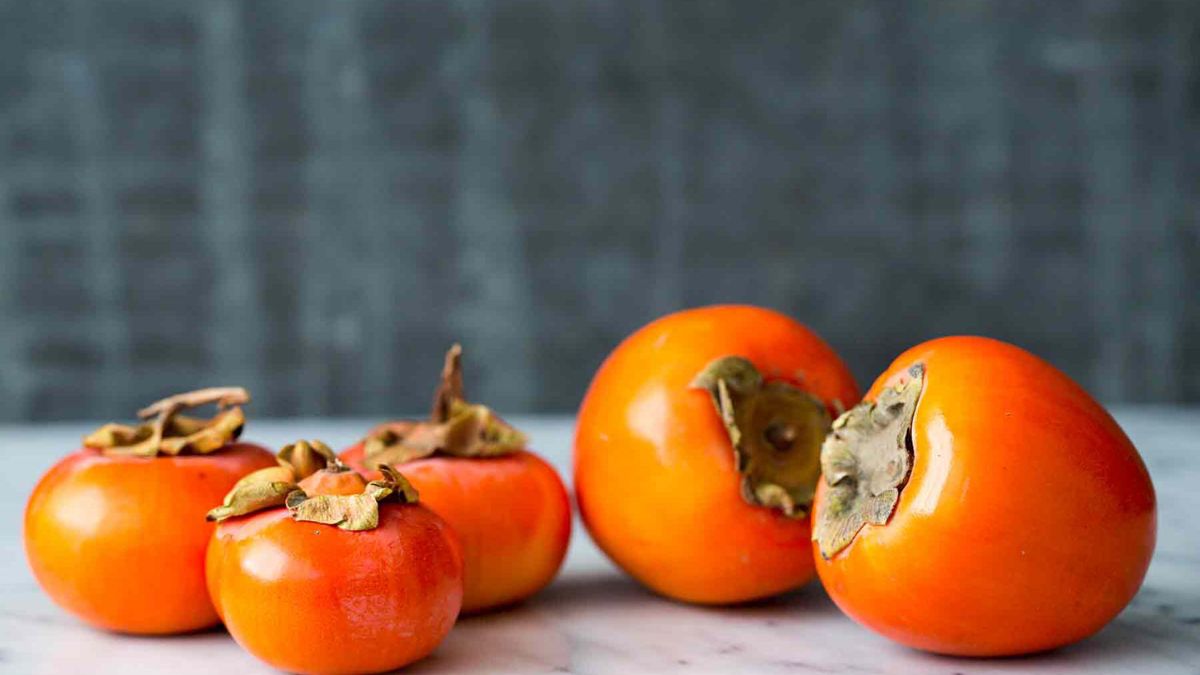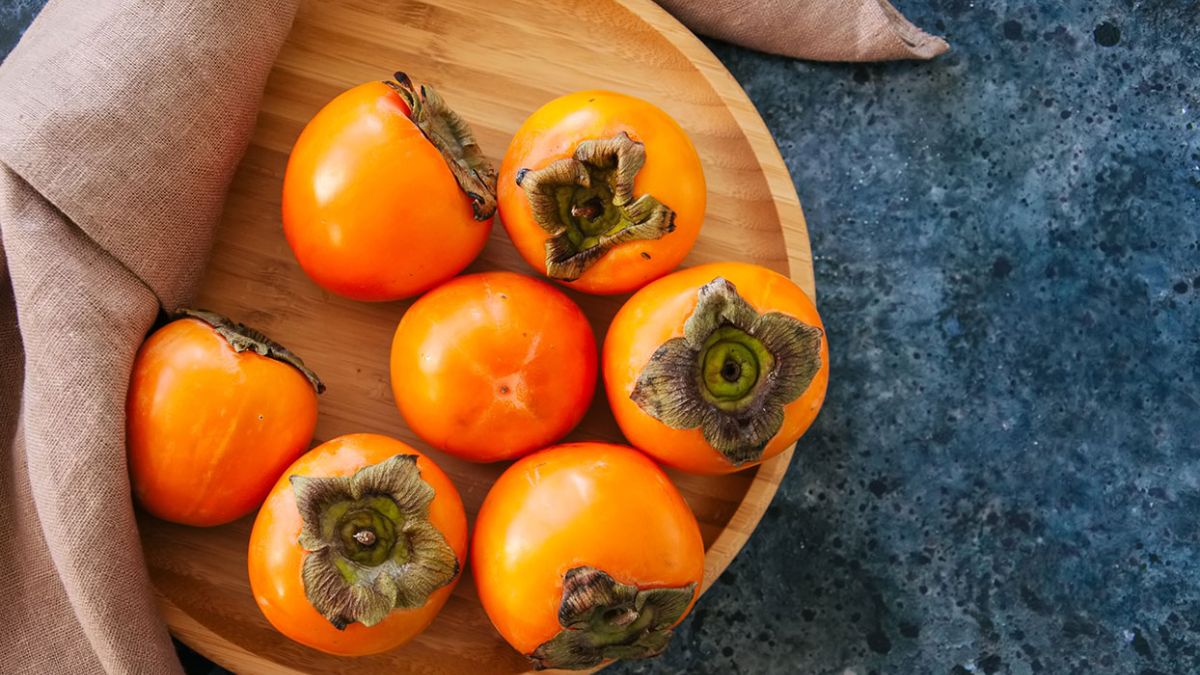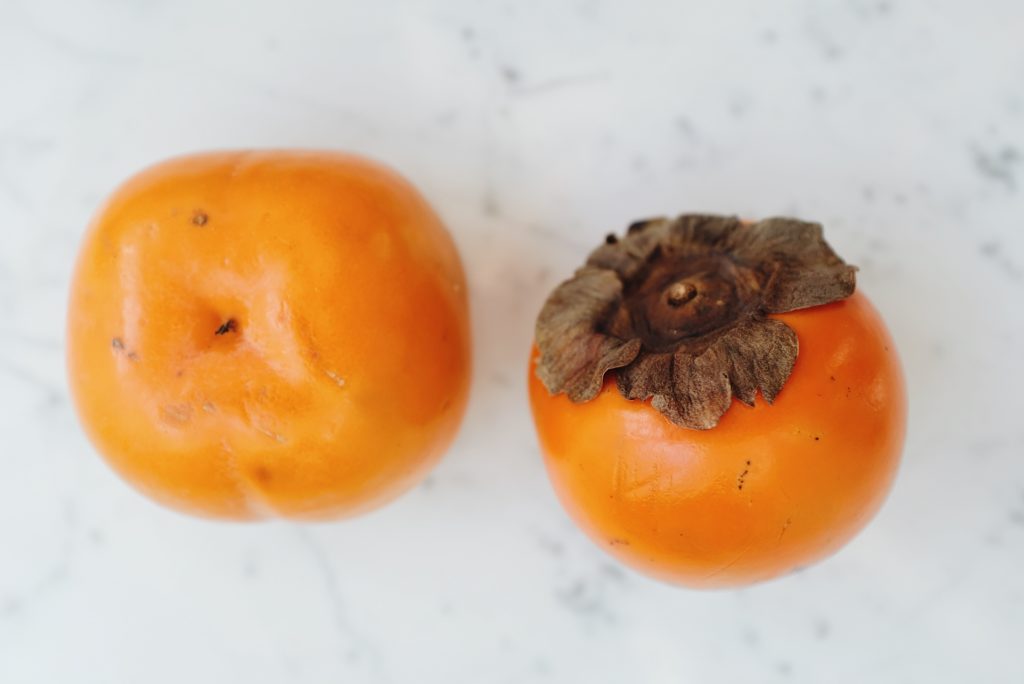People like persimmons because they are brightly coloured and taste sweet. They are called the “fruit of the gods.” China and Japan both like cold-weather fruit, but China grows most of the commercial crops. People often dry them and eat them all year long, especially during the Lunar New Year.
There are many different kinds of this fruit, but they can be put into two main groups: astringent and not astringent. You can eat both types of persimmons raw, cooked, or dried. Persimmon slices are often dried, a treat in many parts of the world. Stores in North America like Trader Joe’s now sell dried persimmons that have not been treated with sulfur.
They are a great way to get fiber, and vitamin C. Persimmons are also liked when they are cooked and mashed or used to make jelly. In the U.S., many people grow persimmons because they look nice, not because they want the fruit. When the persimmons are fully ripe in late fall, they look very pretty, and the orange fruit stands out against the dark wood with no leaves.
During the grey and dreary months of late fall and early winter, a persimmon tree with fruit is often the most colorful thing. If the fruit isn’t picked, it will eventually fall to the ground and make a mushy mess that needs to be cleaned up. If you don’t want to pick the fruit, you’ll have to clean up the tree’s mess to enjoy its beauty. Instead of cleaning up the mess, you could make some persimmon jam or pudding, which would make the tree both pretty and useful.
What are Persimmons?
Persimmons are orange fruits with a stem that looks like a tomato. They grow on trees and start to be picked in late fall. Even though there is a native persimmon in some parts of the United States, most persimmons are Asian. The most common is the fuyu, which looks like an orange tomato and is flat and round. The Hachiya, which looks like an acorn and is dark orange when it’s ready, is the second most popular fruit in America.
Both have a peel that can be eaten and is sometimes taken off, and inside is bright orange flesh. Fresh persimmons are expensive because they are only in season for a short time and are hard to find in the U.S. Persimmons are red to orange fruits that grow on trees in the genus Diospyros. There are many different kinds of fruit that grow in different parts of the world.
This means that the color and shape of the fruit can range from round to teardrop-shaped. Most people grew Kaki persimmons from China but were brought to the U.S. in the 19th century. Persimmons are also native to Mexico, North America, the Philippines, Southeastern Europe, and Asia. Some types of persimmons can’t be eaten, and some people say that none of them are good enough to eat.
Persimmons are a prized fruit for many people, mostly outside North America, but not all Americans don’t like them. This is especially true for people who like persimmon-baked pudding, an old European-American dish with a texture like a pumpkin pie or plum pudding. Some fall and winter meals wouldn’t be the same without persimmon pudding.
Persimmon Varieties
There are many different kinds of these fruits, most of which come from Asia. Asian persimmons come in two main types: Fuyu and Hachiya. You can also find these varieties growing in North America, which can be used to make desserts. Wild trees grow along the edges of cleared fields all over the South, from Maryland to Florida, from the Piedmont of North Carolina to Texas.
Fuyu and Hachiya are the two main types of persimmons that can be bought in stores. Fuyu persimmons are easy to tell apart because they have flat bottoms and are short. Fuyus tend to be lighter orange and taste best when they are a little soft. As they ripen, they get sweeter, but you can eat them at any time. Hachiya persimmons have an oval shape and are long. They have a strong taste and are very sour unless they are perfectly ripe. They will ripen after being picked, just like Fuyu persimmons, so put them on the kitchen counter until you are ready to use them.
Hoshigaki, dried persimmons from Japan, is also made from Chechnya. Hoshigaki are dried persimmons that have been hung up to dry and then massaged to bring the sugars to the outside, making them look like they are covered in frost. They are very chewy and very sweet. American persimmon trees grow in the eastern part of the United States. The fruit can be eaten fresh or used to make baked goods. They are usually not sold commercially because they are bitter before ripe.
How to Cook with Persimmons?
Just before you use them, wash persimmons. Fuyus are ready to eat when their tops and the tougher part of the flesh under the stem are cut off, and they are sliced. You can eat the peel or take it off if you want to. When you find big black seeds, throw them away.
When a Hachiya persimmon is ripe, it is so soft that you can eat it with a spoon. Take off the stem and any tough parts of the plant, use a spoon to get the flesh out of the peel, and enjoy. You can also poach, roast, bake, broil, grill, or dry Fuyu persimmons. Because they have a mild taste, they can be used in sweet and savory dishes. Hachiyas are often used in baked goods because their flesh is so soft when it’s ripe that it’s hard to cut.
What do Persimmons Taste Like?
When ripe, persimmons have a mild flavor similar to pumpkin but add fruity sweetness. Unripe Fuyus are less sweet and slightly tart, with a crisp texture. Hachiya persimmons have a stronger flavor but must be eaten when completely ripe, or they are extremely astringent. Dried persimmons, like most dried fruit, are very sweet.
Fuyu persimmons will also taste tart or bitter until they are fully ripe, but this takes less time, and you can eat them when they feel soft. You can prepare these by cutting off the tops, slicing and peeling them, and removing and throwing away any large black seeds. Since they are firmer than Hachiya persimmons, they can be added to salads or baked in the oven more easily. The taste is light and tastes like honey.
Health Benefits of Persimmons
Persimmons are full of important vitamins, minerals, and antioxidants that are good for your health. Vitamin C, for example, helps the immune system and keeps heart disease at bay. Persimmons also have a lot of soluble fiber, which slows the digestion of carbs and keeps blood sugar from going up too quickly.
Persimmons are also good for your health in other ways, such as:
Heart Health – Persimmons can help clear out your arteries and lower your risk of getting heart disease. Atherosclerosis is the hardening and narrowing of the arteries. One study found that persimmons are high in fiber, antioxidants, and minerals, all of which are part of a diet that helps prevent atherosclerosis.
The tannin-rich fiber in persimmons is especially good at treating high cholesterol.
Eye Health- Persimmons are good for your eyes, and one serving has more than half of the recommended amount of vitamin A, which is good for your eyesight. Also, the peel of persimmon is full of lutein, which is known to help keep eye diseases at bay.
Diabetes Prevention and Reduced Risk of Complications- The flavenoids in the peel of persimmon has been shown to help prevent diabetes and protect cells from damage. They stop harmful compounds called advanced glycation end products (AGEs) from forming in the blood when protein or fat is mixed with sugar. AGEs have been linked to the start of diabetes and the long-term health problems that come with it.
How to Eat Persimmons?
Here are some ways to add persimmons to your diet.
- Eat them on their own
- Add sliced persimmon to salads
- Use instead of apples in pork dishes
- Bake healthy muffins or quick bread
- Add to oatmeal or granola
- Roast persimmons for a healthy dessert
Persimmons are usually only available in the late fall and winter and are not usually sold all year. Fresh persimmons can be found at grocery stores, specialty markets, Asian grocery stores, and farmers’ markets from October to January. Most of the time, the fruit is sold by the pound or the case. Since the season is short, they tend to be more expensive than apples or bananas.
Pick heavy fruit that feels firm and has no soft spots. The best persimmons are the symmetrical ones, since the ones that aren’t can have big seeds. The sun makes the little black dots, which don’t change the taste. Once established, Asian persimmon trees don’t need much care and shouldn’t be pruned much once they bear fruit. Choose fruit that is heavy and has a bright color. The trick is to keep it away from animals that are also hungry and love the fruit.
How to Store Persimmons?
Fuyu persimmons are often sold when they are already ripe and should be kept in the fridge’s crisper drawer. If they aren’t soft enough, leave them on the counter until they are, then put them in the refrigerator. If you keep them dry, whole, and cold, they will last for about two weeks. Hachiyas usually need time to get soft, so put them on the counter at room temperature until they are ready. Put the persimmons and a banana in a paper bag to speed up the process. Hachiyas that are ready to eat can be kept in the fridge for up to a week.
Sliced persimmons should be eaten immediately, and cooked fruit can be kept in a container for up to three days in the fridge. Ripe persimmon purée can be frozen for later use. Keep in a bag or container that won’t let air in and use within three months.
Conclusion
One of the keys to enjoying persimmons is figuring out which kinds are the best to eat. The fruit of the persimmon tree can be either sour or sweet. Persimmons with many tannins, like the Korean and Hachiya varieties, must be fully ripe or treated specially. If you eat them before they are ready, the tannins in the fruit pucker your mouth and make it hard to eat.
They can be treated with chemicals, but a common way to make them ready to eat is to freeze them for a few hours or wait to pick them up until after the first frost. Fruits like Fuyu, Hiro, and Hanagosho are not thought to be astringent. Still, they can make your mouth pucker a little. To lessen this effect, you can freeze them or pick them up after it gets cold.
The peel is not eaten with either type of persimmon, and the fruit is just peeled and cut up like an apple to eat. It can have a firm or soft texture depending on when the fruit is picked. Firmer Persimmons are easier to eat, but the softer and more jelly-like ones are sweeter.


